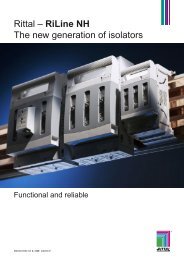You also want an ePaper? Increase the reach of your titles
YUMPU automatically turns print PDFs into web optimized ePapers that Google loves.
Air/water heat exchangers<br />
Calculate your required cooling output.<br />
e. g. performance diagram<br />
Air/water heat exchanger 1000 W<br />
Model No. <strong>SK</strong> 3217.100<br />
.<br />
QK<br />
1750<br />
1500<br />
1250<br />
1000<br />
750<br />
500<br />
250<br />
5<br />
45 °C<br />
35 °C<br />
25 °C<br />
TW<br />
<strong>Rittal</strong> <strong>System</strong> <strong>Climate</strong> <strong>Control</strong><br />
. .<br />
QE = Qv <strong>–</strong> k � A � ΔT<br />
.<br />
VW = 400 l/h<br />
.<br />
VW .<br />
= 200 l/h<br />
VW = 100 l/h<br />
Ti<br />
10 15 20 25 30<br />
Tw = Water inlet temperature (°C)<br />
.<br />
QK= Continuous useful cooling output (W)<br />
Ti = Enclosure internal temperature (°C)<br />
Notes on water quality<br />
For safe operation of the equipment, it is essential to observe<br />
the VBG guidelines on cooling water (VGB R 455 P).<br />
Cooling water must not contain any limescale deposits or<br />
loose debris; in other words, it should have a low level of<br />
hardness, particularly a low level of carbon hardness. For<br />
recooling within the plant, the carbon hardness should not be<br />
too high. On the other hand, however, the water should not<br />
be so soft that it attacks the operating materials. When<br />
recooling the cooling water, the salt content should not be<br />
allowed to increase excessively due to the evaporation of<br />
large quantities of water, since electrical conductivity<br />
increases as the concentration of dissolved substances<br />
rises, and the water thereby becomes more corrosive. For<br />
this reason, not only is it always necessary to add a corresponding<br />
quantity of fresh water, but also to remove part of<br />
the enriched water.<br />
Gypsiferous water is unsuitable for cooling purposes<br />
because it has a tendency to form boiler scale, which is particularly<br />
difficult to remove. Furthermore, cooling water<br />
should be free from iron and manganese, because otherwise<br />
deposits may occur which settle in the pipes and block<br />
them. At best, organic substances should only be present in<br />
small quantities, because otherwise sludge deposits and<br />
microbiological contamination may occur.<br />
Project planning<br />
Air/water heat exchanger<br />
Material of water-carrying parts<br />
Hydrological data CuAl V4A1) pH value 7 <strong>–</strong> 8,5 6 <strong>–</strong> 9<br />
Carbon hardness > 3 < 8° dH 1 <strong>–</strong> 12° dH<br />
Free carbonic acid 8 <strong>–</strong> 15 mg/dm3 1 <strong>–</strong> 100 mg/dm3 Accompanying carbonic acid 8 <strong>–</strong> 15 mg/dm3 free<br />
Aggressive carbonic acid 0 mg/dm3 0 <strong>–</strong> 400 mg/dm3 Sulphides free free<br />
Oxygen < 10 mg/dm3 < 10 mg/dm3 Chloride ions < 50 mg/dm3 < 200 mg/dm3 Sulphate ions < 250 mg/dm3 < 500 mg/dm3 Nitrates and nitrites < 10 mg/dm3 < 100 mg/dm3 COD < 7 mg/dm3 < 40 mg/dm3 Ammonia < 5 mg/dm3 < 20 mg/dm3 Iron < 0.2 mg/dm3 free<br />
Manganese < 0.2 mg/dm3 free<br />
Conductivity < 2200 µS/cm < 4000 µS/cm<br />
Residue on evaporation < 500 mg/dm3 < 200 mg/dm3 Potassium permanganate<br />
consumption<br />
< 25 mg/dm3 < 40 mg/dm3 < 3 mg/dm3 > 3 < 15 mg/dm<br />
Suspended matter<br />
3 partial current purification<br />
recommended<br />
> 15 mg/dm3 continuous purification<br />
recommended<br />
1) The complete absence of corrosion under experimental conditions suggests<br />
that solutions with a significantly higher salt content and greater corrosion<br />
potential (such as seawater) may still be tolerated.<br />
29<br />
3.4





